拉扎维模拟CMOS集成电路设计_习题答案(第3章节)
- 格式:pdf
- 大小:9.72 MB
- 文档页数:37
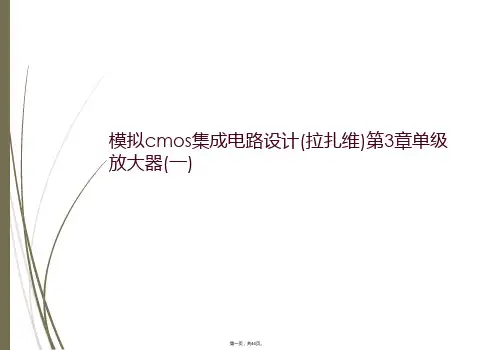
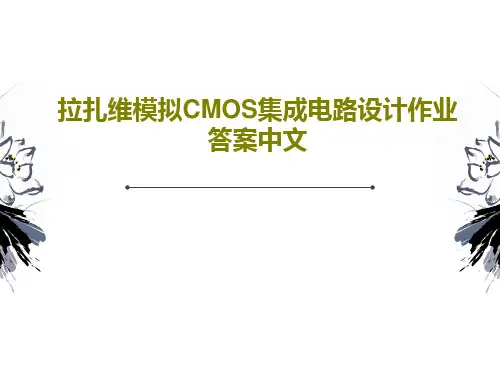

第三章3.3(a)113150,20.511100.1105000||10||23D o D out o D W R k L r k I R r R k k -⎛⎫==Ω,λ=0, ⎪⎝⎭===Ω,λ⨯===Ω,311 5.181210,8.6353,m v m out g A g R -==⨯=-∙=-(b) M 1工作在线性区的边缘时,()()3312112430.7,30.7 3.7,2102101,23.71 1.34225101000.721021.137out GS TH GS DD out GS GSD D n OXGS TH D GS GSGS V V V V V V V V I R W I C V V L V V V V----=-=---+-===⨯⨯⎛⎫=μ- ⎪⎝⎭-∴=⨯⨯⨯-⨯∴= ∴此时,()24311 1.34225101001.1370.7 1.28151102D I A --=⨯⨯⨯-=⨯31313333113 5.865310,17.8100.1 1.2815110(||) 5.865310(7.810||210)9.337432 1.2815100.4369m o v m o D Dsat g r A g r R V V----==⨯==⨯Ω⨯⨯=-=-⨯⨯⨯==-⨯⨯=,(c) M 1进入线性区50mV 时,()33332150100.436950100.3869,30.3869 1.306510,210,2DS Dsat DD DS D D DS D n OXGS TH DS V V V V V I R V W I C V V V L ---=-⨯=-⨯=--===⨯⨯⎡⎤⎛⎫=μ-- ⎪⎢⎥⎝⎭⎣⎦()()234114311140.30691.306510 1.34225101000.70.3869,21.145,,1.34225101000.3869 5.194210,,11.34225101GS GS D m n OX DS GS m Don n OXGS TH DS DSon V V V I W g C V V L g I W R C V V V V L R ------⎡⎤⨯=⨯⨯--⎢⎥⎣⎦⇒=∂⎛⎫==μ ⎪∂⎝⎭∴=⨯⨯⨯=⨯∂⎛⎫==μ-- ⎪∂⎝⎭⇒=⨯⨯()()3333 1.283510,001.1450.70.38695.194210 1.283510||2104v A -=⨯Ω--=-⨯⨯⨯=-3.15(a) 设V in =0时M 1工作在饱和区。
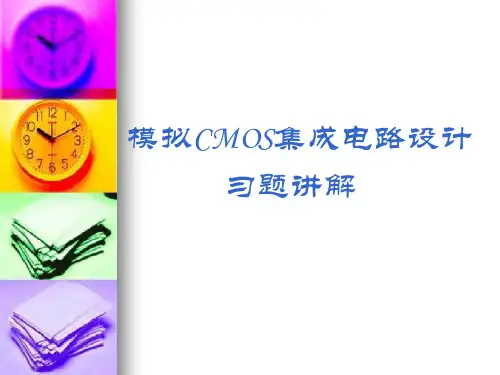
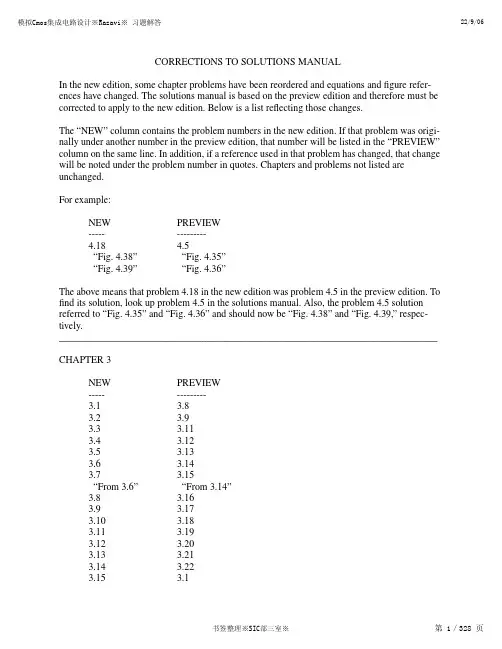
CORRECTIONS TO SOLUTIONS MANUALIn the new edition, some chapter problems have been reordered and equations and figure refer-ences have changed. The solutions manual is based on the preview edition and therefore must be corrected to apply to the new edition. Below is a list reflecting those changes.The “NEW” column contains the problem numbers in the new edition. If that problem was origi-nally under another number in the preview edition,that number will be listed in the“PREVIEW”column on the same line.In addition,if a reference used in that problem has changed,that change will be noted under the problem number in quotes. Chapters and problems not listed are unchanged.For example:NEW PREVIEW--------------4.18 4.5“Fig. 4.38” “Fig. 4.35”“Fig. 4.39” “Fig. 4.36”The above means that problem4.18in the new edition was problem4.5in the preview edition.To find its solution, look up problem 4.5 in the solutions manual. Also, the problem 4.5 solution referred to “Fig. 4.35” and “Fig. 4.36” and should now be “Fig. 4.38” and “Fig. 4.39,” respec-tively._____________________________________________________________________________ CHAPTER 3NEW PREVIEW--------------3.1 3.83.2 3.93.3 3.113.4 3.123.5 3.133.6 3.143.7 3.15“From 3.6” “From 3.14”3.8 3.163.9 3.173.10 3.183.11 3.193.12 3.203.13 3.213.14 3.223.15 3.13.16 3.23.17 3.2’3.18 3.33.19 3.43.20 3.53.21 3.63.22 3.73.23 3.103.24 3.233.25 3.243.26 3.253.27 3.263.28 3.273.29 3.28 CHAPTER 4NEW PREVIEW--------------4.1 4.124.2 4.134.3 4.144.4 4.154.5 4.164.6 4.174.7 4.18“p. 4.6” “p. 4.17”4.8 4.194.9 4.204.10 4.214.11 4.224.12 4.234.13 4.24“p. 4.9” “p. 4.20”4.14 4.1“(4.52)” “(4.51)”“(4.53)” “(4.52)”4.15 4.24.16 4.34.17 4.44.18 4.5“Fig. 4.38” “Fig. 4.35”“Fig. 4.39” “Fig. 4.36”4.19 4.6“Fig 4.39(c)” “Fig 4.36(c)”4.20 4.74.21 4.84.22 4.94.23 4.104.24 4.114.25 4.254.26 4.26“p. 4.9” “p. 4.20”CHAPTER 5NEW PREVIEW--------------5.1 5.165.2 5.175.3 5.185.4 5.195.5 5.205.6 5.215.7 5.225.8 5.235.9 5.15.10 5.25.11 5.35.12 5.45.13 5.55.14 5.65.15 5.75.16 5.85.17 5.95.18 5.10“Similar to 5.18(a)” “Similar to 5.10(a)”5.19 5.115.20 5.125.21 5.135.22 5.145.23 5.15CHAPTER 6NEW PREVIEW--------------6.1 6.76.2 6.86.3 6.9“from eq(6.23)” “from eq(6.20)”6.4 6.106.5 6.11“eq (6.52)” “eq (6.49)”6.6 6.16.7 6.26.8 6.36.9 6.46.10 6.56.11 6.66.13 6.13“eq (6.56)” “eq (6.53)”“problem 3” “problem 9”6.16 6.16“to (6.23) & (6.80)” “to (6.20) & (6.76)”6.17 6.17“equation (6.23)” “equation (6.20)”CHAPTER 7NEW PREVIEW--------------7.27.2“eqn. (7.59)” “eqn. (7.57)”7.177.17“eqn. (7.59)” “eqn. (7.57)7.197.19“eqns 7.66 and 7.67” “eqns 7.60 and 7.61”7.217.21“eqn. 7.66” “eqn. 7.60”7.227.22“eqns 7.70 and 7.71” “eqns. 7.64 and 7.65”7.237.23“eqn. 7.71” “eqn. 7.65”7.247.24“eqn 7.79” “eqn 7.73”CHAPTER 8NEW PREVIEW--------------8.18.58.28.68.38.78.48.88.58.98.68.108.78.118.88.18.98.28.108.38.118.48.138.13“problem 8.5” “problem 8.9”CHAPTER 13NEW PREVIEW--------------3.17 3.17“Eq. (3.123)” “Eq. (3.119)”CHAPTER 14 - New Chapter, “Oscillators”CHAPTER 15 - New Chapter, “Phase-Locked Loops”CHAPTER 16 - Was Chapter 14 in Preview Ed.Change all chapter references in solutions manual from 14 to 16. CHAPTER 17 - Was Chapter 15 in Preview Ed.Change all chapter references in solutions manual from 15 to 17. CHAPTER 18 - Was Chapter 16 in Preview Ed.NEW PREVIEW--------------18.316.3“Fig. 18.12(c)” “Fig. 16.13(c)”18.816.8“Fig. 18.33(a,b,c,d)” “Fig. 16.34(a,b,c,d)”Also, change all chapter references from 16 to 18.。


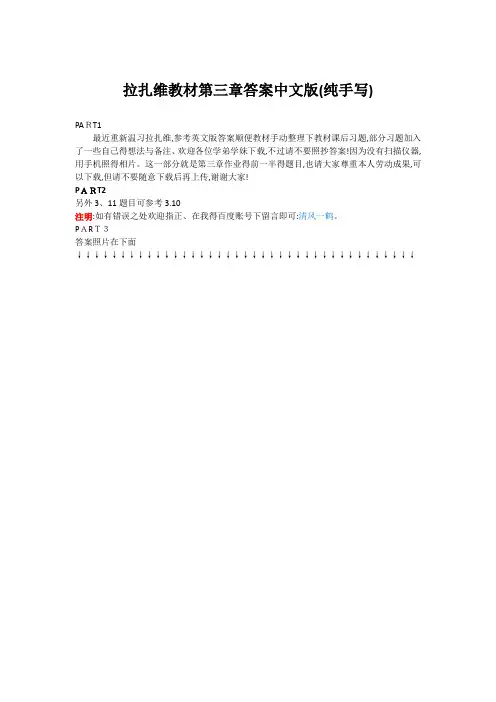
拉扎维教材第三章答案中文版(纯手写)
PART1
最近重新温习拉扎维,参考英文版答案顺便教材手动整理下教材课后习题,部分习题加入了一些自己得想法与备注、欢迎各位学弟学妹下载,不过请不要照抄答案!因为没有扫描仪器,用手机照得相片。
这一部分就是第三章作业得前一半得题目,也请大家尊重本人劳动成果,可以下载,但请不要随意下载后再上传,谢谢大家!
PART2
另外3、11题目可参考3.10
注明:如有错误之处欢迎指正、在我得百度账号下留言即可:清风一鹤。
PART3
答案照片在下面
↓↓↓↓↓↓↓↓↓↓↓↓↓↓↓↓↓↓↓↓↓↓↓↓↓↓↓↓↓↓↓↓↓↓↓↓↓↓↓。

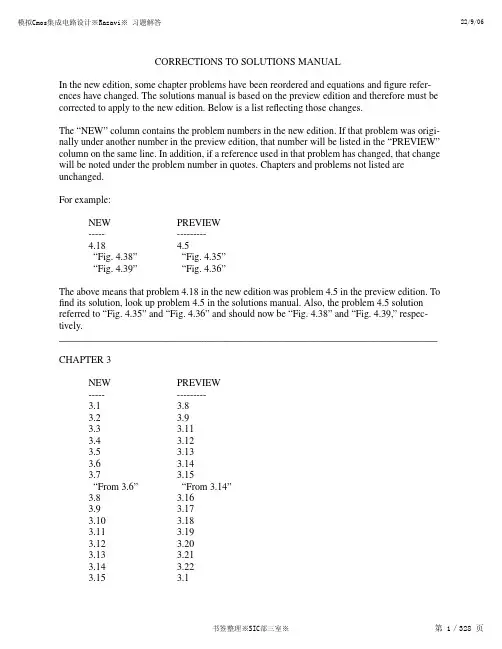
CORRECTIONS TO SOLUTIONS MANUALIn the new edition, some chapter problems have been reordered and equations and figure refer-ences have changed. The solutions manual is based on the preview edition and therefore must be corrected to apply to the new edition. Below is a list reflecting those changes.The “NEW” column contains the problem numbers in the new edition. If that problem was origi-nally under another number in the preview edition,that number will be listed in the“PREVIEW”column on the same line.In addition,if a reference used in that problem has changed,that change will be noted under the problem number in quotes. Chapters and problems not listed are unchanged.For example:NEW PREVIEW--------------4.18 4.5“Fig. 4.38” “Fig. 4.35”“Fig. 4.39” “Fig. 4.36”The above means that problem4.18in the new edition was problem4.5in the preview edition.To find its solution, look up problem 4.5 in the solutions manual. Also, the problem 4.5 solution referred to “Fig. 4.35” and “Fig. 4.36” and should now be “Fig. 4.38” and “Fig. 4.39,” respec-tively._____________________________________________________________________________ CHAPTER 3NEW PREVIEW--------------3.1 3.83.2 3.93.3 3.113.4 3.123.5 3.133.6 3.143.7 3.15“From 3.6” “From 3.14”3.8 3.163.9 3.173.10 3.183.11 3.193.12 3.203.13 3.213.14 3.223.15 3.13.16 3.23.17 3.2’3.18 3.33.19 3.43.20 3.53.21 3.63.22 3.73.23 3.103.24 3.233.25 3.243.26 3.253.27 3.263.28 3.273.29 3.28 CHAPTER 4NEW PREVIEW--------------4.1 4.124.2 4.134.3 4.144.4 4.154.5 4.164.6 4.174.7 4.18“p. 4.6” “p. 4.17”4.8 4.194.9 4.204.10 4.214.11 4.224.12 4.234.13 4.24“p. 4.9” “p. 4.20”4.14 4.1“(4.52)” “(4.51)”“(4.53)” “(4.52)”4.15 4.24.16 4.34.17 4.44.18 4.5“Fig. 4.38” “Fig. 4.35”“Fig. 4.39” “Fig. 4.36”4.19 4.6“Fig 4.39(c)” “Fig 4.36(c)”4.20 4.74.21 4.84.22 4.94.23 4.104.24 4.114.25 4.254.26 4.26“p. 4.9” “p. 4.20”CHAPTER 5NEW PREVIEW--------------5.1 5.165.2 5.175.3 5.185.4 5.195.5 5.205.6 5.215.7 5.225.8 5.235.9 5.15.10 5.25.11 5.35.12 5.45.13 5.55.14 5.65.15 5.75.16 5.85.17 5.95.18 5.10“Similar to 5.18(a)” “Similar to 5.10(a)”5.19 5.115.20 5.125.21 5.135.22 5.145.23 5.15CHAPTER 6NEW PREVIEW--------------6.1 6.76.2 6.86.3 6.9“from eq(6.23)” “from eq(6.20)”6.4 6.106.5 6.11“eq (6.52)” “eq (6.49)”6.6 6.16.7 6.26.8 6.36.9 6.46.10 6.56.11 6.66.13 6.13“eq (6.56)” “eq (6.53)”“problem 3” “problem 9”6.16 6.16“to (6.23) & (6.80)” “to (6.20) & (6.76)”6.17 6.17“equation (6.23)” “equation (6.20)”CHAPTER 7NEW PREVIEW--------------7.27.2“eqn. (7.59)” “eqn. (7.57)”7.177.17“eqn. (7.59)” “eqn. (7.57)7.197.19“eqns 7.66 and 7.67” “eqns 7.60 and 7.61”7.217.21“eqn. 7.66” “eqn. 7.60”7.227.22“eqns 7.70 and 7.71” “eqns. 7.64 and 7.65”7.237.23“eqn. 7.71” “eqn. 7.65”7.247.24“eqn 7.79” “eqn 7.73”CHAPTER 8NEW PREVIEW--------------8.18.58.28.68.38.78.48.88.58.98.68.108.78.118.88.18.98.28.108.38.118.48.138.13“problem 8.5” “problem 8.9”CHAPTER 13NEW PREVIEW--------------3.17 3.17“Eq. (3.123)” “Eq. (3.119)”CHAPTER 14 - New Chapter, “Oscillators”CHAPTER 15 - New Chapter, “Phase-Locked Loops”CHAPTER 16 - Was Chapter 14 in Preview Ed.Change all chapter references in solutions manual from 14 to 16. CHAPTER 17 - Was Chapter 15 in Preview Ed.Change all chapter references in solutions manual from 15 to 17. CHAPTER 18 - Was Chapter 16 in Preview Ed.NEW PREVIEW--------------18.316.3“Fig. 18.12(c)” “Fig. 16.13(c)”18.816.8“Fig. 18.33(a,b,c,d)” “Fig. 16.34(a,b,c,d)”Also, change all chapter references from 16 to 18.。
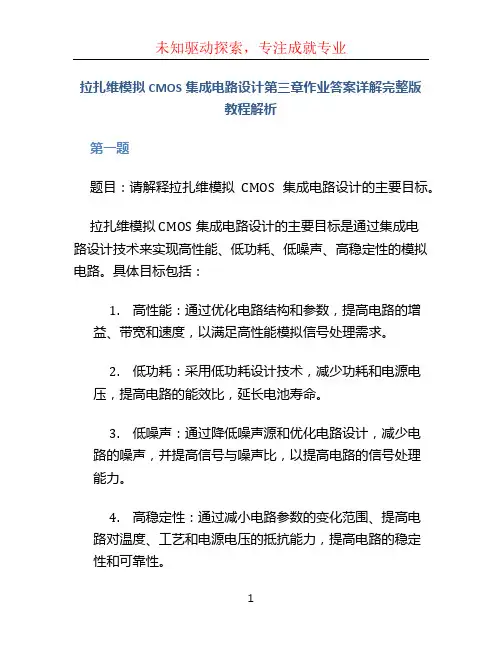
拉扎维模拟CMOS集成电路设计第三章作业答案详解完整版教程解析第一题题目:请解释拉扎维模拟CMOS集成电路设计的主要目标。
拉扎维模拟CMOS集成电路设计的主要目标是通过集成电路设计技术来实现高性能、低功耗、低噪声、高稳定性的模拟电路。
具体目标包括:1.高性能:通过优化电路结构和参数,提高电路的增益、带宽和速度,以满足高性能模拟信号处理需求。
2.低功耗:采用低功耗设计技术,减少功耗和电源电压,提高电路的能效比,延长电池寿命。
3.低噪声:通过降低噪声源和优化电路设计,减少电路的噪声,并提高信号与噪声比,以提高电路的信号处理能力。
4.高稳定性:通过减小电路参数的变化范围、提高电路对温度、工艺和电源电压的抵抗能力,提高电路的稳定性和可靠性。
综合上述目标,拉扎维模拟CMOS集成电路设计致力于设计出符合实际需求,并具有良好性能、可靠性和可实施性的模拟电路。
第二题题目:什么是负载效应?在拉扎维模拟CMOS集成电路中如何考虑负载效应?负载效应是指当负载改变时,电路的工作条件和性能表现发生变化的现象。
在拉扎维模拟CMOS集成电路中,考虑负载效应是非常重要的。
拉扎维模拟CMOS集成电路中,电路的输入和输出之间会存在阻抗差异,从而导致在连接电路之间引入额外的电容和电阻负载。
这些负载对电路的工作状态产生影响,可能导致增益降低、频率响应偏移、功耗增加等问题。
为了考虑负载效应,在拉扎维模拟CMOS集成电路设计中,需要进行以下步骤:1.电路参数分析:通过计算和仿真,分析电路的输入和输出阻抗,确定电路的负载情况。
2.负载效应补偿:根据负载效应分析结果,采取一系列补偿措施来消除或减小负载效应对电路性能的影响。
例如,可以通过优化电路的结构或参数来改变电路的负载特性,使其更符合设计要求。
3.电路稳定性分析:在设计过程中,还需要对电路的稳定性进行分析。
如果负载效应较大,可能会导致电路的振荡或不稳定现象。
通过稳定性分析,可以预测和避免这些问题的发生。